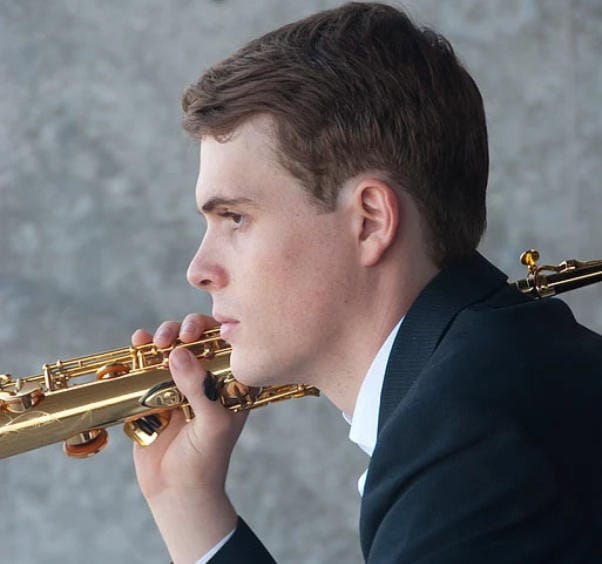Jeffrey Siegfried fell in love with the saxophone when he was 9 years old and never looked back. Now 22 years later, he is making his debut with the Vancouver Symphony Orchestra, replacing Albert Julia who has had visa problems, to perform Paul Creston’s “Concerto for Saxophone and Orchestra” this weekend.
You could even say that Siegfried wasted no time beginning his professional career. That’s because he would play simple tunes outside his elementary school in Bellingham, and parents responded by tossing quarters into his music case.
“In my family, music lessons were the most important thing,” Siegfried said. “Even my great grandparents thought that music lessons came before food. My grandfathers on both sides of the family were trained singers.”
Siegfried stuck with the saxophone, earning master’s degrees in performance and in musicology from Northwestern University and a doctorate in saxophone with certificates in musicology and in performance studies from the University of Michigan. Earlier this year he joined the music faculty of Western Virginia University as an assistant professor.
If You Go
What: Jeffrey Siegfried plays the Creston “Concerto for Saxophone and Orchestra” with the Vancouver Symphony Orchestra.
When: 3 p.m. Saturday and 7 p.m. Sunday.
Where: Skyview High School Concert Hall, 1300 N.W. 139th St., Vancouver.
Cost: $52 for reserved seats, $40 for general admission, $36 for seniors and $10 for students.
He has also excelled in competitions, winning the Luminarts Fellowship Competition and the Frances Walton Competition and receiving the 2016 Hans Schaeuble Award. Siegfried has appeared as a featured soloist with the U.S. Army Band and performed as an orchestral saxophonist with the Chicago Symphony, the New World Symphony and Spoleto Festival USA. Over the last few weeks, he has toured with the The Moanin’ Frogs, a sextet of virtuosic saxophonists.
Comfortable with both jazz and classical styles, Siegfried is particularly well-matched for the Creston piece because it contains subtle jazz influences.
“Some of the tonal content was used in the jazz world, but it is not a pastiche of jazz. It’s sophisticated and not obvious,” said Siegfried. “There are passages where Creston uses two different time signatures at the same time. … It reminds me of styles that Gershwin and Cole Porter used. But sometimes the soloist has the regular tempo, and the orchestra comes in and destabilizes the meter.”
Creston’s concerto has three movements with descriptive names: “Energetic,” “Meditative,” and “Rhythmic.”
“The first movement makes a dramatic statement,” Siegfried said. “The second movement is expressive and sweet with a big cadenza. The third movement really burns. It features double-tonguing. Has a lot of fireworks. The piece is very beautiful and deserves to be played more often.”
Creston had an unorthodox career path. Born Giuseppe Guttoveggio, he was the child of poor Italian immigrants and had to drop out of high school after two years. He taught himself how to write music, studying great works during his free time while working various odd jobs and became a church organist. He found acclaim for his compositions and after receiving a Guggenheim fellowship, he began to teach, retiring from Central Washington University in 1975.
Creston was a contemporary of Samuel Barber, whose “First Essay for Orchestra” will open the concert. It was given an auspicious premiere by Arturo Toscanini and the NBC Symphony Orchestra as part of a radio broadcast. After starting slowly, this short work picks up the pace, becoming more agitated and exciting until it reaches the end where the first solemn theme is boldly restated.
The second half of the concert will feature Brahms’ Second Symphony. Known for its light and cheerful melodies, Brahms wrote this symphonic work while vacationing one summer in rural Austria. In the span of four movements, the music evokes fresh breezes, sunshine, and the pastoral countryside. With music director Salvador Brotons conducting, it will cap off the concert with a smile.



